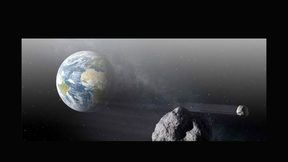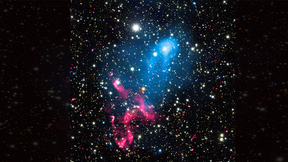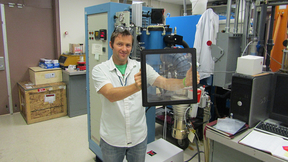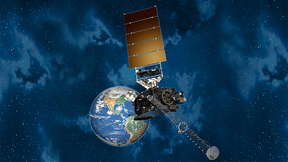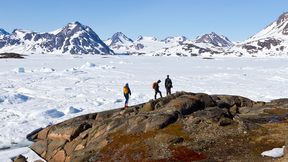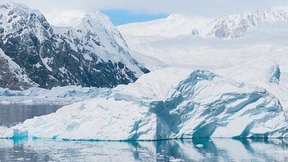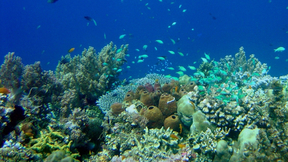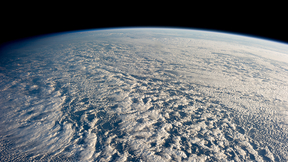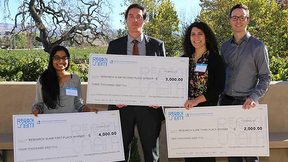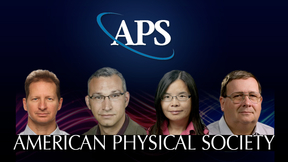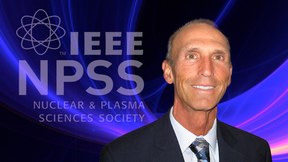Back
Physical and Life Sciences
Janus Laser Furthers Planetary Defense Research
Defending Earth against incoming asteroids—uncommon but potentially catastrophic threats—is no easy task. Without convenient, cost-effective ways to experiment directly on asteroids in the solar system, scientists run simulations and conduct high-energy-density experiments on asteroid fragments with lasers. Those who need to study matter under extreme conditions find a…
Recreating conditions inside stars in the laboratory with compact lasers
Using compact lasers, a team including Lawrence Livermore National Laboratory (LLNL) scientists has created pressures more than a billion atmospheres, equivalent to the pressure in the center of a star.These conditions of extreme pressure and energy density have previously been created in the laboratory only with the world's largest lasers, which are the size of stadiums…
Going inside to get a more efficient catalyst
New research shows that the phases that nano-structured materials go through to become an efficient catalyst are as good as gold.Lawrence Livermore National Laboratory (LLNL) material scientist Juergen Biener and collaborators found that by restructuring nanoporous gold alloys they become more efficient catalysts.Nano-structured materials hold promise for improving…
Lab materials scientist accepts joint appointment with Washington State
Staff scientist Mukul Kumar from the Materials Engineering Division will serve a joint position with both Lawrence Livermore National Laboratory (LLNL) and Washington State University (WSU). This is only the third joint appointment for LLNL. Joint appointments tie both institutions together in a more formal way and contribute to work that is mutually beneficial.Kumar will…
Astronomers discover cosmic double whammy
Astronomers have discovered a cosmic one-two punch unlike any ever seen before. Two of the most powerful phenomena in the universe, a supermassive black hole and the collision of giant galaxy clusters, have combined to create a stupendous cosmic particle accelerator.By combining data from NASA’s Chandra X-ray Observatory, the Giant Metrewave Radio Telescope (GMRT) in India…
Novel Scintillator Improves X-Ray Imaging
A Livermore team has developed a first-of-its kind transparent ceramic scintillator that significantly improves throughput for CT-based 3D imaging for manufacturing and other applications.
Lord of the Rings – synthesizing a five-membered ring nitrogen compound
Lawrence Livermore National Laboratory (LLNL) scientists in collaboration with University of South Florida theorists recently reported the synthesis and equation of state of a long sought-after five-ring nitrogen (N5) compound.The ring-structure compounds, known as pentazolates, are the last all-nitrogen members of the azole series. They have been notoriously elusive for…
Lab technology on board space weather monitoring satellite
Lawrence Livermore National Laboratory (LLNL) scientists and collaborators have developed a key technology for one of the instruments that are flying on board the next generation of Geostationary Operational Environmental Satellites (GOES), as part of the National Oceanic and Atmospheric Administration (NOAA)’s space weather monitoring fleet launched late last month.GOES-R…
East Greenland ice sheet has responded to climate change for the last 7.5 million years
Using marine sediment cores containing isotopes of aluminum and beryllium, a group of international researchers has discovered that East Greenland experienced deep, ongoing glacial erosion over the past 7.5 million years. The research reconstructs ice sheet erosion dynamics in that region during the past 7.5 million years and has potential implications for how much the ice…
UCOP awards grants and fellowships to collaborate with Lawrence Livermore
The University of California Office of the President awarded more than $14 million to four grants and four graduate fellowships to collaborate with staff scientists at Lawrence Livermore and Los Alamos national laboratories. UC scientists received $7.9 million to work with Lawrence Livermore researchers on two of the research grants and two in-residence graduate…
Thinning of Antarctic glacier began in 1940s
New research by an international team shows that the present thinning and retreat of Pine Island Glacier in West Antarctica is part of a climatically forced trend that was triggered in the 1940s. The team -- made up of scientists from Lawrence Livermore National Laboratory, the British Antarctic Survey, University of Copenhagen, University of Alaska, Naval Postgraduate…
Friedmann receives Greenman Award
Lawrence Livermore National Laboratory (LLNL) energy guru Julio Friedmann has been honored with the Greenman Award by the Greenhouse Gas Control Technologies (GHGT) conference series. Friedmann is recognized for his tireless efforts to promote carbon capture and storage, particularly at large scale. This award is given to those who have made career-scale impact on the…
New measurements of oceanic organic matter help scientists in understanding of climate
Researchers have found that new measurements of the size, age and composition of organic matter in the Pacific Ocean affects short-term and long-term climate impacts. The findings could have implications for climate in terms of how long organic matter is stored in the ocean before being converted into CO2 and re-entering the atmosphere. Marine organic matter is one of…
Mineral increases solar cell efficiency
A mineral found in nature may be the key to more efficient solar panels. New research by Lawrence Livermore National Laboratory (LLNL) material scientist Marcus Worsley and colleagues from UC Berkeley and Lawrence Berkeley National Laboratory shows that using the mineral perovskite in graded band gap solar cells achieves an average steady efficiency rate of 21.7 percent…
Cloudy feedback on global warming
Lawrence Livermore National Laboratory researchers have identified a mechanism that causes low clouds -- and their influence on Earth’s energy balance -- to respond differently to global warming, depending on their spatial pattern and location. The results imply that studies relying solely on recent observed trends underestimated how much Earth will warm due to increased…
GEOS Team Aims for Exascale Target
Massively parallel physics simulations provide Lawrence Livermore with a wealth of data to complement experimental observation. Within the Physical and Life Sciences Directorate, computational geoscience is a cornerstone of the Atmospheric, Earth, and Energy Division's (AEED) efforts to advance energy and environmental technology. Because the nation's security depends in…
PLS postdocs embrace Research Slam
Picture this: it's the day of your first poster presentation as a postdoc. You've picked out your best professional suit (or your only professional suit, reserved just for this occasion), your poster has been beautifully printed with help from the Lab's print plant, and your heart is racing with nerves and excitement. Your first interested visitor stops by, quizzically…
Four Lawrence Livermore National Lab researchers selected as 2016 APS Fellows
LIVERMORE, California – Four Lawrence Livermore National Laboratory (LLNL) scientists have been selected as 2016 fellows of the American Physical Society (APS). Election to APS fellowship recognizes the society member’s exceptional contributions to the field of physics through research, leadership, applications of physics or contributions to physics education. APS…
LLNL scientists develop a new method to measure radiation dose in cancer patients
Lawrence Livermore National Laboratory (LLNL) scientists and collaborators have developed a new technique to measure radiation dose levels using gene expression analysis of whole blood from cancer patients receiving targeted radiation therapy. There are unique challenges to estimate the internal dose after radiotherapy is administered. The current practice of calculating…
Fusion award honors LLNL scientist's career
The Institute of Electrical and Electronics Engineers’ (IEEE) Nuclear & Plasma Sciences Society (NPSS) selected Lawrence Livermore National Laboratory (LLNL) researcher Wayne Meier as the recipient of their 2016 Fusion Technology Award. The award will be presented at the 2017 Symposium on Fusion Engineering June 4-8 in Shanghai, China. The Fusion Technology Award…


